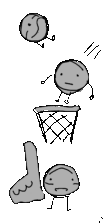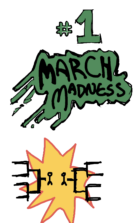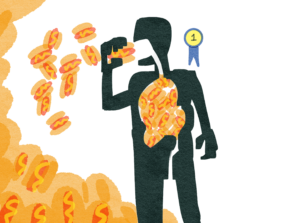
Eden Kwan
While it may not include running or catching a ball, competitive eating is in fact considered a sport — and is one that is growing in popularity thanks to its high-stakes nature and the rise of social media. The spectacle can be both fascinating and unsettling, capturing viewers with its unique nature and leaving them unable to look away.
While competitive eating may appear to be a modern phenomenon, records of competitive eaters date back as early as the seventeenth century, such as Nicholas Wood, also known as The Great Eater of Kent. Featured in a 1630 pamphlet, Wood’s stunts included eating a whole raw sheep at once, seven dozen rabbits in one meal and four hundred pigeons in another meal.
Fast forward to today and competitive eating has evolved into a global spectacle, with one of its most iconic events being Nathan’s Hot Dog Eating Contest, which takes place every year on the Fourth of July in New York City. During the event, the contestant who eats the most hot dogs and buns within 10 minutes wins and takes home a grand prize of $10,000. The contest is broadcast nationally on ESPN and has helped propel many to fame, most notably Joey Chestnut, who has won the competition sixteen times and set the record by eating seventy-six hot dogs in 2021. Chestnut won his titles between 2007 to 2023, with only one notable loss to Matt Stonie, a San Jose native, who ate sixty-two hot dogs compared to Chestnut’s sixty.
Like many other competitive eaters, Stonie documents his contests on social media, specifically YouTube, where his channel has amassed over 16.4 million subscribers and 3.7 billion views. On his channel, Stonie frequently competes against other competitive eaters and takes on food challenges, including eating one thousand slices of bologna and one hundred slices of cheese. Social media influencers have played a significant role in boosting the popularity of the sport, as competitive eating videos and televised contests such as Nathan’s gain more and more viewers every year.
However, while eating competitions may be gaining traction globally, many Aragon students appear to be indifferent or completely unfamiliar with the topic.
“I definitely can’t name a single competitive eater,” said junior Julia Baltodano. “I don’t really like those types of videos; they kind of gross me out.”
Like Baltodano, many consider competitive eating off-putting and unappealing, given the extreme quantities of food consumed and the often messy and frantic nature of the event. While these contests may seem grotesque to some, they also raise concerns about the impact they could have on the health of competitors. In preparation for big events, athletes often fast for several days, which can lead to dehydration, metabolic shifts and malnutrition.
Aside from choking being a major risk during the competition, competitive eating poses many long-term threats to athletes as well. According to the National Institute of Health, frequently consuming tens of thousands of calories within minutes can have consequences such as intractable nausea, gastric perforation, tearing of the esophagus and morbid obesity. Although the stomachs of professional eaters appear to have unique properties, like the ability to expand to an unnatural size, health professionals are concerned that years of chronic overeating can result in severe muscular dysfunction and even cancer. These health concerns have led some to criticize the sport for promoting unhealthy eating habits, especially on impressionable adolescents through social media.
“I don’t think it’s entertaining or healthy to encourage unhealthy eating patterns,” said senior Iris Daily. “Binge eating is a serious problem, especially in the U.S., with larger portion sizes and highly processed and unhealthy foods being so common”.
But it’s not just eating competitions that are gaining popularity. Food-related videos, in general, are on the rise, as social media users like Baltodano have noticed an increase in eating content on her feed.
“I see a lot more eating videos on TikTok and Instagram than I used to,” Baltodano said. “And it’s not just ASMR, it’s people eating massive portions.”
With the rise of media glorifying overconsumption and competitive eating, unhealthy eating habits are becoming more and more normalized, potentially leading to harmful behaviors surrounding food consumption. While most Aragon students may not be fans of the sport, with its growing popularity, competitive eating could begin to alter the public’s view of what defines a healthy diet.
“The future impact could just be even higher rates of obesity if eating such a large quantity is encouraged or romanticized,” Daily said.
As competitive eating has yet to reach Aragon, many students remain indifferent or repelled by the sport. However, as food-related entertainment continues to grow in media, it could be only a matter of time before eating competitions become a school sport.



